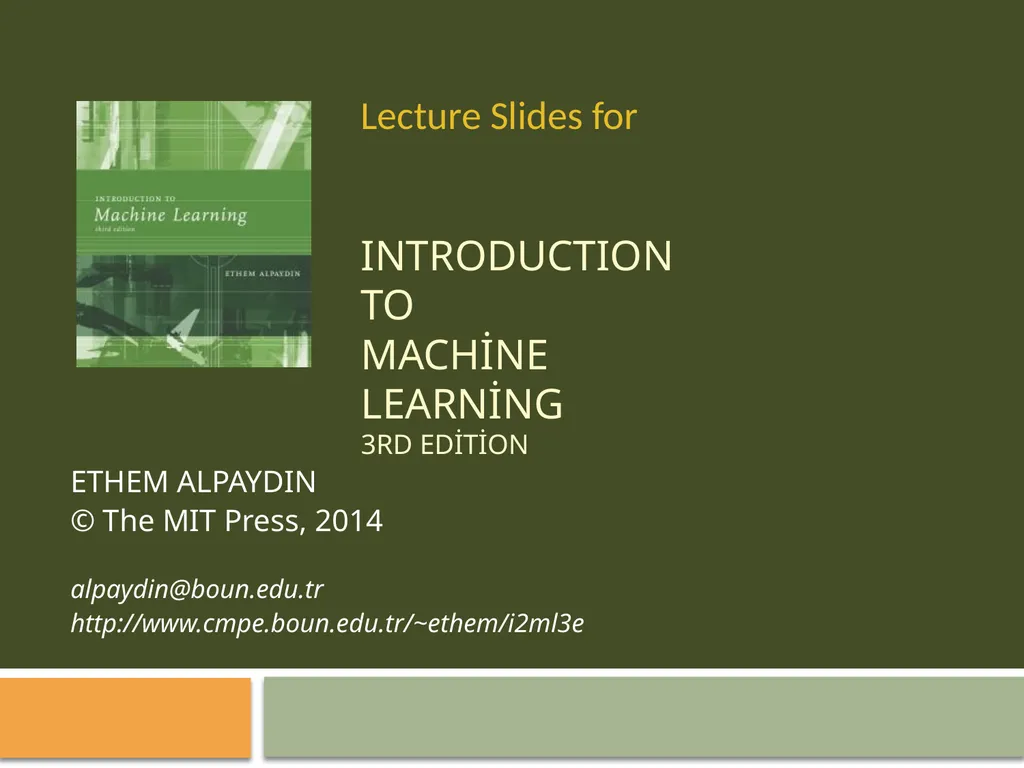INTRODUCTION TO Machine Learning 3rd Edition ETHEM
Author : stefany-barnette | Published Date : 2025-05-12
Description: INTRODUCTION TO Machine Learning 3rd Edition ETHEM ALPAYDIN The MIT Press 2014 alpaydinbounedutr httpwwwcmpebounedutrethemi2ml3e Lecture Slides for CHAPTER 5 Multivariate Methods Multivariate Data 3 Multiple measurements
Presentation Embed Code
Download Presentation
Download
Presentation The PPT/PDF document
"INTRODUCTION TO Machine Learning 3rd Edition ETHEM" is the property of its rightful owner.
Permission is granted to download and print the materials on this website for personal, non-commercial use only,
and to display it on your personal computer provided you do not modify the materials and that you retain all
copyright notices contained in the materials. By downloading content from our website, you accept the terms of
this agreement.
Transcript:INTRODUCTION TO Machine Learning 3rd Edition ETHEM:
INTRODUCTION TO Machine Learning 3rd Edition ETHEM ALPAYDIN © The MIT Press, 2014 alpaydin@boun.edu.tr http://www.cmpe.boun.edu.tr/~ethem/i2ml3e Lecture Slides for CHAPTER 5: Multivariate Methods Multivariate Data 3 Multiple measurements (sensors) d inputs/features/attributes: d-variate N instances/observations/examples Multivariate Parameters 4 Parameter Estimation 5 Estimation of Missing Values 6 What to do if certain instances have missing attributes? Ignore those instances: not a good idea if the sample is small Use ‘missing’ as an attribute: may give information Imputation: Fill in the missing value Mean imputation: Use the most likely value (e.g., mean) Imputation by regression: Predict based on other attributes Multivariate Normal Distribution 7 Multivariate Normal Distribution 8 Mahalanobis distance: (x – μ)T ∑–1 (x – μ) measures the distance from x to μ in terms of ∑ (normalizes for difference in variances and correlations) Bivariate: d = 2 Bivariate Normal 9 10 Independent Inputs: Naive Bayes 11 If xi are independent, offdiagonals of ∑ are 0, Mahalanobis distance reduces to weighted (by 1/σi) Euclidean distance: If variances are also equal, reduces to Euclidean distance Parametric Classification If p (x | Ci ) ~ N ( μi , ∑i ) Discriminant functions 12 Estimation of Parameters 13 Different Si Quadratic discriminant 14 15 likelihoods posterior for C1 discriminant: P (C1|x ) = 0.5 Common Covariance Matrix S 16 Shared common sample covariance S Discriminant reduces to which is a linear discriminant Common Covariance Matrix S 17 Diagonal S 18 When xj j = 1,..d, are independent, ∑ is diagonal p (x|Ci) = ∏j p (xj |Ci) (Naive Bayes’ assumption) Classify based on weighted Euclidean distance (in sj units) to the nearest mean Diagonal S 19 variances may be different Diagonal S, equal variances 20 Nearest mean classifier: Classify based on Euclidean distance to the nearest mean Each mean can be considered a prototype or template and this is template matching Diagonal S, equal variances 21 * ? Model Selection 22 As we increase complexity (less restricted S), bias decreases and variance increases Assume simple models (allow some bias) to control variance (regularization) 23 Discrete Features 24 Binary features: if xj are independent (Naive Bayes’) the discriminant is linear Estimated parameters Discrete Features 25 Multinomial (1-of-nj) features: xj Î {v1, v2,..., vnj} if xj are independent Multivariate Regression 26 Multivariate linear model Multivariate polynomial model: Define new higher-order variables z1=x1, z2=x2, z3=x12, z4=x22, z5=x1x2 and use the linear model in this new z space (basis














![[READ]-Machine Learning: Two-Book Bundle: Machine Learning: Master the Three Types of](https://thumbs.docslides.com/986795/read-machine-learning-two-book-bundle-machine-learning-master-the-three-types-of-machine-learning-hacking-computer-hacking-mastery.jpg)